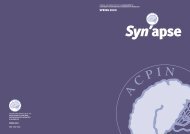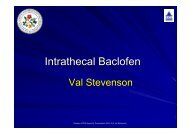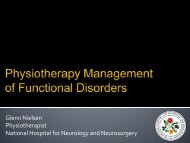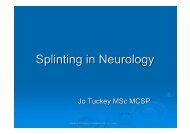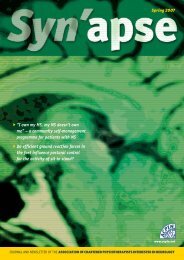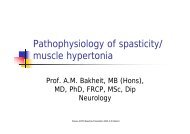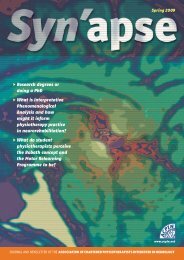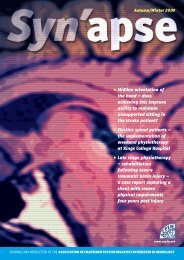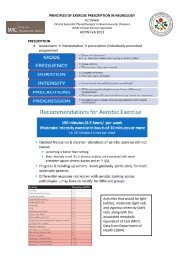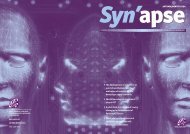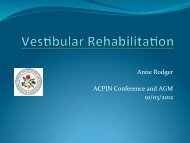SYNAPSE November 2001 - acpin
SYNAPSE November 2001 - acpin
SYNAPSE November 2001 - acpin
You also want an ePaper? Increase the reach of your titles
YUMPU automatically turns print PDFs into web optimized ePapers that Google loves.
Syn’apse ● AUTUMN <strong>2001</strong><br />
ARTICLE 3<br />
Richard D Abbott<br />
BSc(hons) Psychol, BSc<br />
(hons) MCSP, SRP<br />
Senior Physiotherapist<br />
Birmingham Heartlands<br />
Hospital.<br />
Nonorganic origins Alternative possible<br />
causes for hemiplegic symptoms and signs:<br />
a case study<br />
Hemiplegia and unilateral loss of function is classically<br />
associated with an identifiable organic cause<br />
such as a bleed, infarction or tumour involving either<br />
the cerebral hemispheres, mid or hind brain.<br />
Cases are documented within the literature in<br />
which neurological syndromes including hemiplegia<br />
have been produced in patients with personality<br />
disorders and a concomitant previous history of<br />
feigning physical symptoms and signs (Bauer and<br />
Boegner 1996), (Biver, Delvenne, Hirsch, Lotstra<br />
1992).<br />
This report describes a case study in which inconsistencies<br />
were noted in a patient’s presenting signs of<br />
unilateral functional loss. It was noted that during a review<br />
of his medical records, summary phrases<br />
including ‘functional loss’ and ‘probable cerebrovascular<br />
accident’ were used and a firm diagnosis of<br />
organic origin was not made during his admission.<br />
The concepts of conversion disorder, malingering,<br />
factitious disorder and Munchausen’s syndrome are<br />
defined in a bid to elucidate possible non-organic<br />
causes for such presentations. Notably however, the<br />
responsibility of diagnosis lies firmly within the field<br />
of psychiatry, and no attempt was made to label the patient’s<br />
problems in this case.<br />
The psychological concepts of ‘locus of control’,<br />
behaviourism and role theory are introduced and a<br />
means of managing the patient’s problems in the light<br />
of these are described.<br />
DEFINITIONS<br />
The following definitions are taken from a psychological<br />
dictionary, psychology texts and journal articles<br />
generated by Medline search strategies.<br />
• Conversion Disorder ‘A psychopathological syndrome<br />
characterised by the “conversion” of<br />
psychic conflict into somatic form. The resulting<br />
functional disorder may appear superficially to<br />
have physical or physiological causes but may frequently<br />
follow no organic system. The symptoms<br />
manifested usually produce some secondary gain<br />
for the individual such as the avoidance of some<br />
noxious activity or garnering of support and concern<br />
from others’ (Reber 1985, P157).<br />
• Malingering ‘The deliberate feigning of illness,<br />
disability or incompetence’ (Reber 1985 p4l5.)<br />
This contrasts with ‘conversion disorder’ where the<br />
symptoms are not produced intentionally.<br />
• Factitious disorders The most common of these is<br />
that in which the patient presents with plausible<br />
physical symptoms that are apparently under the<br />
individual’s control (Reber 1985). Symptoms include<br />
those such as back pain, nausea, vomiting,<br />
dizziness, and amongst others, rashes. The<br />
patient’s medical knowledge and imagination are<br />
the only limits (Reber 1985). Less commonly the<br />
individual produces various symptoms of psychological<br />
disorders seemingly under the voluntary<br />
control of the individual (Bauer & Boegner 1996).<br />
Here the condition is virtually always superimposed<br />
on a severe personality disorder although the<br />
displayed symptoms are not explained by that disorder.<br />
For example a patient complains of memory<br />
loss and hallucinations and has been secretly found<br />
to have been taking various drugs to produce these<br />
symptoms in a bid to feign a nonorganic mental disorder<br />
(Reber 1985).<br />
Malingering and having a factitious disorder are<br />
the same in that both involve individuals displaying<br />
symptoms and signs that are under voluntary control<br />
and have no organic basis. The difference lies<br />
in the origins of the behaviour. In the case of malingering,<br />
the person claims he or she is ill for a<br />
particular purpose; the diagnosis of a factitious disorder<br />
is reserved for those that feign illness for no<br />
other reason other than to play the sick role<br />
(Eisendrath 1996).<br />
• Munchausen’s Syndrome A specific variant of factitious<br />
disorder with physical symptoms in which<br />
the patient has had multiple admissions to hospital<br />
and often has had surgical procedures performed<br />
(Mayer 1978, (Reber 1985). Other characteristics<br />
typically include aggressive behaviour, self discharge<br />
from hospital and wandering off the ward<br />
and throughout the hospital during their stay<br />
(Mayer 1978).<br />
All of the above can be responsible for producing<br />
motor and sensory symptoms that would otherwise be<br />
consistent with lesions of the central nervous system<br />
including balance and gait disturbances, incoordination<br />
and limb paralysis, sensory and speech<br />
disturbances for example.<br />
Separating out the respective contributions of genuine<br />
neurological impairment from the factitious and<br />
hysterical is problematic even for psychiatrists and<br />
psychologists. The following case study illustrates that<br />
once the relative contribution of genuine neurological<br />
impairment has been established by completing the<br />
neurological assessment as is customary in neurophysiotherapy,<br />
psychologically based strategies are<br />
available to assist with the overall management of the<br />
patient.<br />
MR H<br />
Mr H, an international coach driver, presented to out<br />
patient physiotherapy with left sided incoordination<br />
and weakness. Medical investigations during his admission<br />
as an in-patient consisted of a computerised<br />
tomography (CT) scan and lumbar puncture, both of<br />
which were reported as unremarkable. A summary of<br />
his problems are listed as follows:<br />
• Dysfunction within the left upper and lower limb<br />
manifested by unilateral incoordination during<br />
functional activities of gait and dressing.<br />
• A reliable reduction in sensation to light touch confined<br />
to his ‘hemiplegic’ side.<br />
• A marked stammer for which he was receiving outpatient<br />
speech and language therapy.<br />
Socially, this gentleman was a divorcee and currently<br />
engaged to a new partner. They had a child of<br />
thirteen months old who was currently receiving physiotherapy<br />
treatment for cerebral palsy. Mr H remained<br />
off work following his ‘stroke’ and returned regularly<br />
to perform voluntary tasks such as coach cleaning<br />
until such time as he could resume his driver duties.<br />
He reported having no current hobbies.<br />
Subjectively he presented as a cheerful man who<br />
engaged freely in conversation involving a variety of<br />
topics such as work, previous hobbies and his forthcoming<br />
marriage. Little difficulty was encountered in<br />
establishing a rapport.<br />
Objectively, he displayed a marked asymmetry in<br />
his movement ability often using his sound side to assist<br />
his affected side, with regular vocal and physical<br />
expressions of dissatisfaction with the upper limb in<br />
particular such as ‘tutting’, ‘huffing’ or grabbing his affected<br />
hand roughly to reposition it.<br />
On examination, his tone appeared to lie within<br />
normal limits. There were no signs of hyper-reflexia,<br />
ataxia, associated reactions during effort or heightened<br />
emotion, clonus, abnormal babinski or spatial<br />
neglect. Sensation was difficult to assess reliably although<br />
he reported sensory loss involving the entirety<br />
of his affected side. His movement disturbances appeared<br />
to worsen when attention was directed to his<br />
affected upper limb in particular. Speech disruption<br />
also deteriorated further following references to such<br />
during treatment sessions. Selective activity in his<br />
upper limb was notably poor during discrete tasks involving<br />
fine and gross motor control. In contrast when<br />
assessing automatic movement, his balance and saving<br />
reactions were disproportionately sharp with consistent<br />
demonstrations of undelayed, smooth, accurate<br />
movement in both upper and lower limb which was<br />
unhampered by any evidence of tonal anomalies.<br />
Good tone and proximal stability were demonstrated<br />
with Mr H positioned prone over a gym ball.<br />
Furthermore, fatigue was not a significant factor as he<br />
could maintain this position and perform a variety of<br />
exercises in which the left upper limb was loaded with<br />
progressively increasing amounts of body weight.<br />
Good muscle definition had been preserved and there<br />
were no marked differences in appearance or muscle<br />
bulk diameter.<br />
His gait pattern was markedly asymmetrical with<br />
notably poor selective hip and knee flexor activity to<br />
effect swing through. There were no joint range restrictions<br />
and fatigability fell within normal limits<br />
around the hip during stance phase; there was no evidence<br />
of a trendelenberg sign.<br />
In summary Mr H presents with symptoms and<br />
signs which are not consistent with a disease process<br />
involving an organic system. A level of psychological<br />
contribution for at least part of his presenting difficulties<br />
would not be an unreasonable premise.<br />
TREATMENT RATIONALE<br />
The origins of Mr H’s movement problems appear inconsistent<br />
with those stemming from a neurological<br />
impairment. The use of specific mobilisation techniques<br />
aimed at normalising tone and facilitating<br />
normal movement were felt likely to play less of a role<br />
in re-establishing this patient’s function, given that his<br />
nervous system was capable of demonstrating perfect<br />
balance and reactions during specific tasks. An attempt<br />
to provisionally diagnose a particular<br />
psychological disorder or problem would not be<br />
within the remit of physiotherapy although recognition<br />
of its potential influence on rehabilitation assisted<br />
the overall management.<br />
Confronting the patient with statements declaring<br />
the lack of organic basis for their complaint has been<br />
shown to be beneficial only in selected cases of factitious<br />
disorders where communication links between<br />
the patient and the psychiatrist are good; this in turn<br />
requires a particular degree of skill (van der Feltz-<br />
Comelis 2000) The same author states that studies<br />
examining the role of confrontation in dealing with<br />
factitious disorder are rare and quote a case of poor<br />
therapeutic outcome when confrontation was blunt.<br />
Furthermore, in a separate article by Sutherland and<br />
Rodin (1990), factitious disorder has been associated<br />
with mortality. Given the complexity of a conversion<br />
disorder which requires appropriate specialist assistance<br />
to resolve the underlying psychological conflict,<br />
and the potentially disastrous consequences of<br />
10<br />
11




